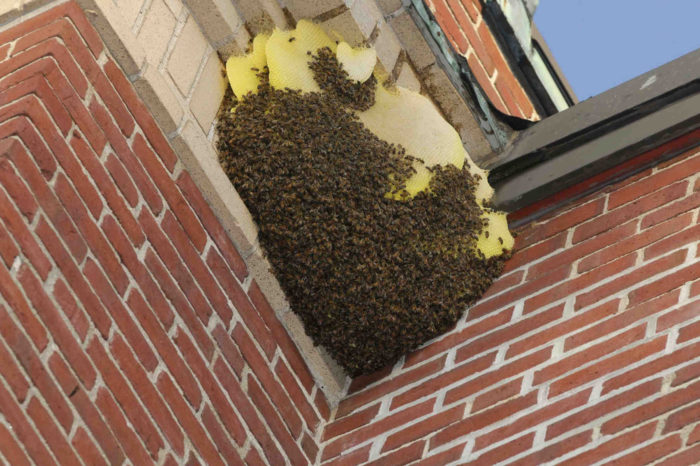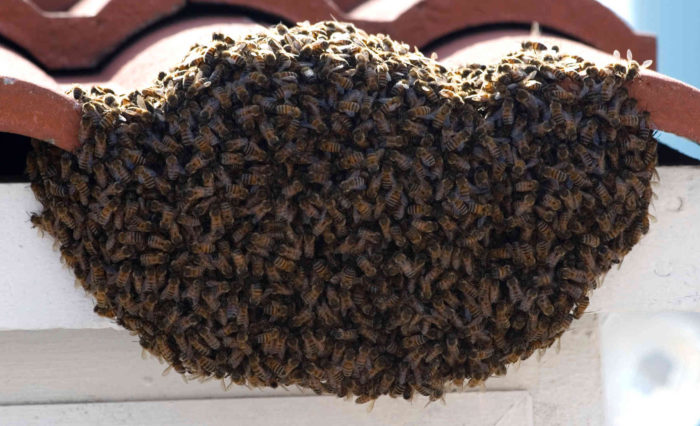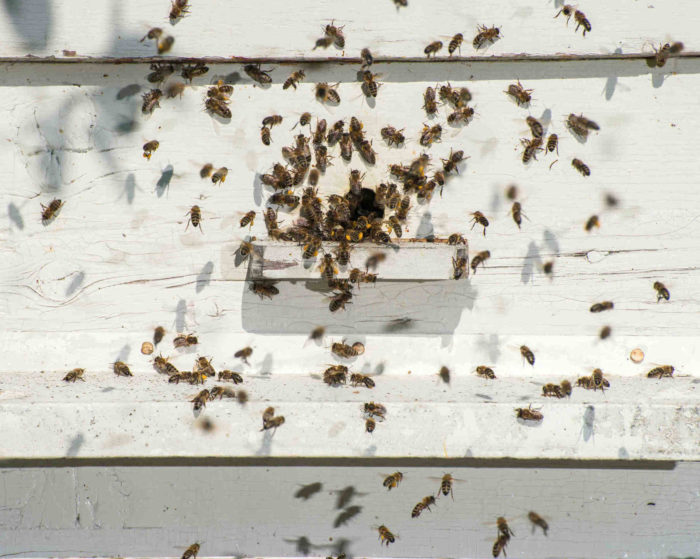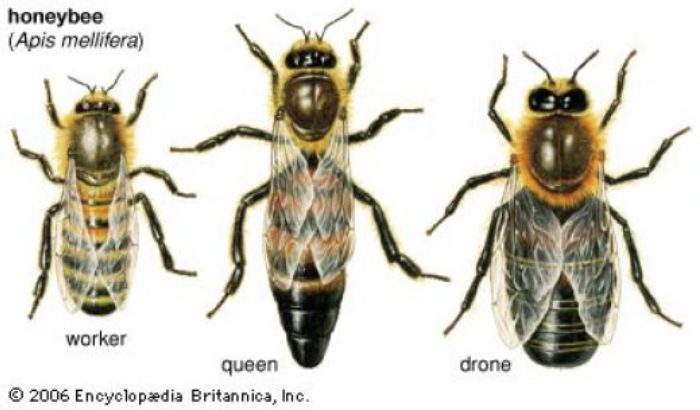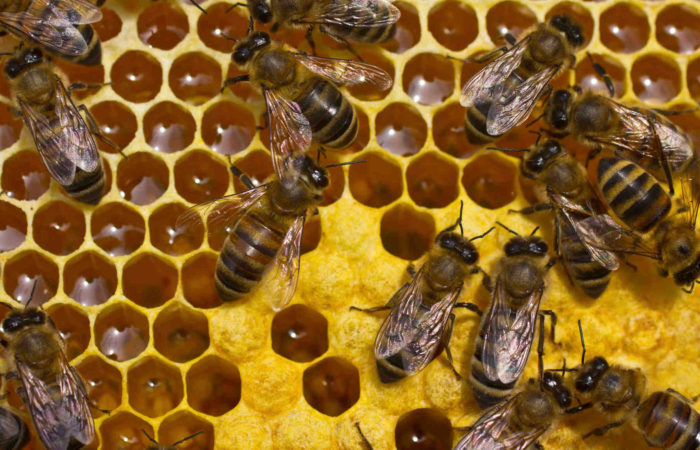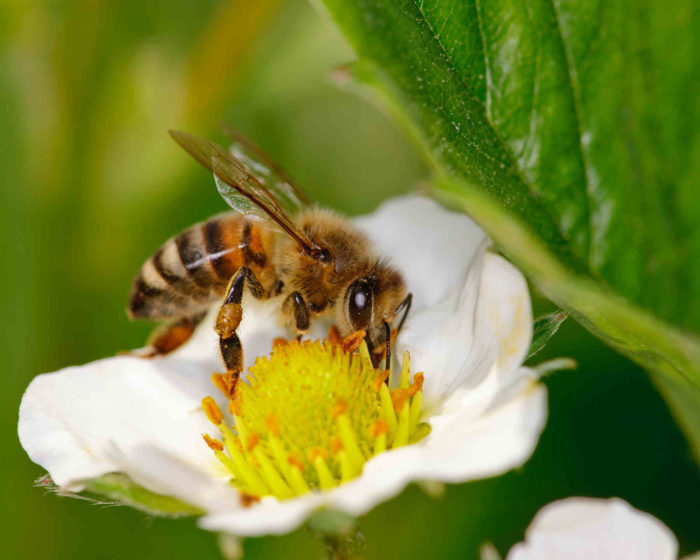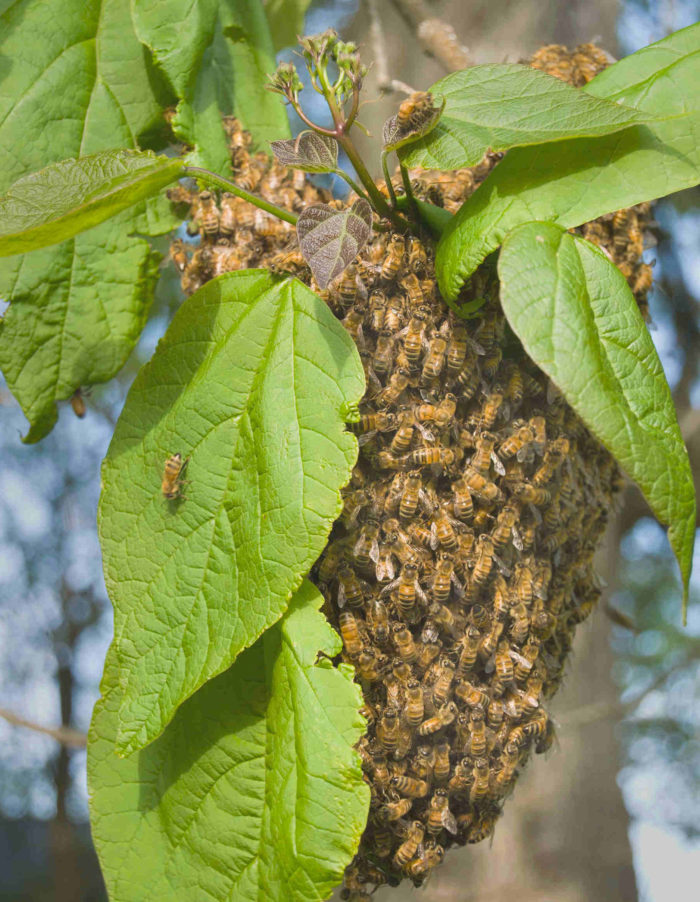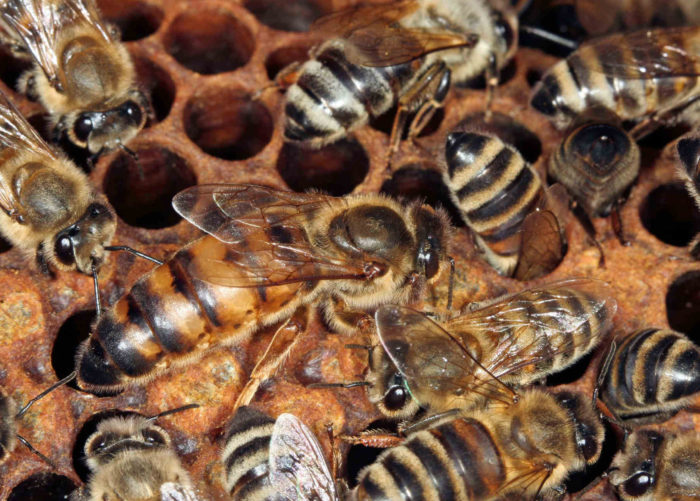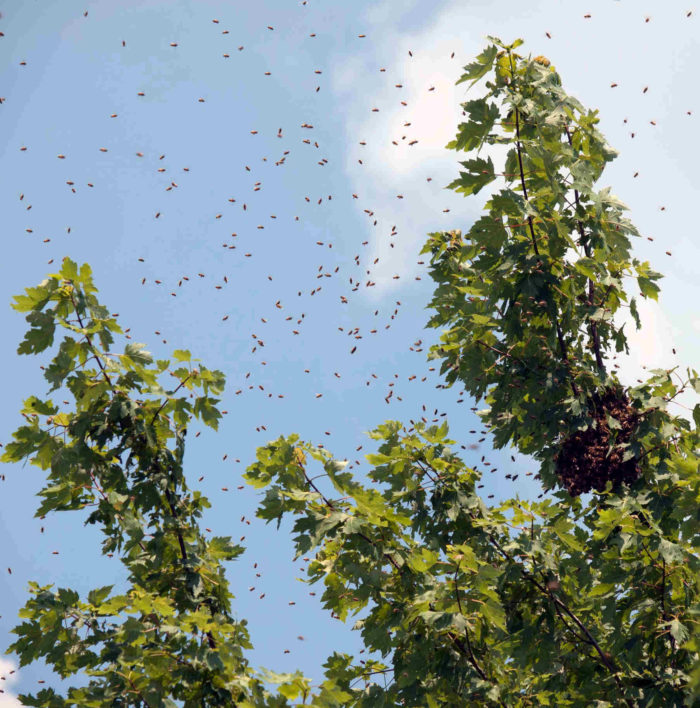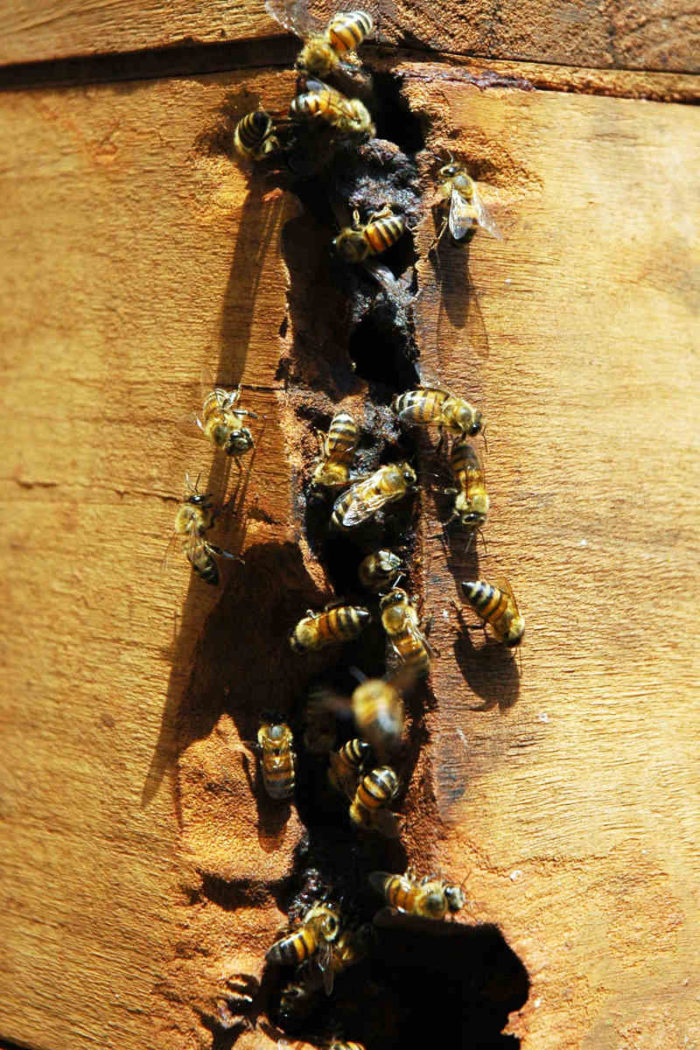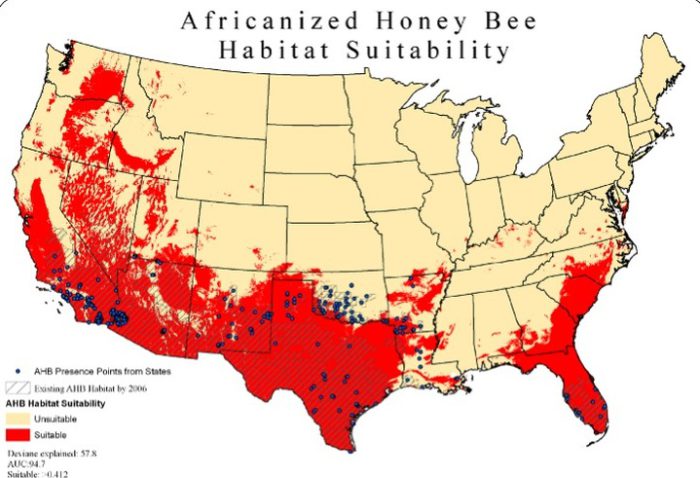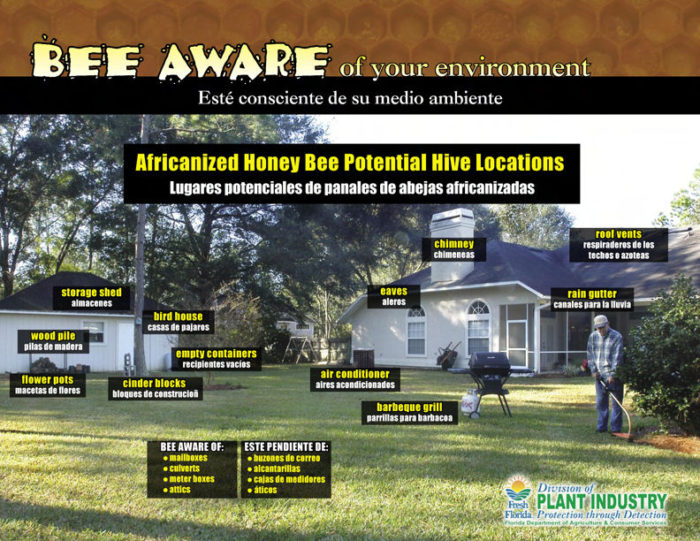BEE REMOVAL AND CONTROL SERVICES IN DALLAS, HOUSTON
The Rodent Control Experts ™
Omega Bee Removal
Omega Animal Removal is the Nation’s Leading Bee Removal Firm
We hear news about how honeybees take residency in the most unexpected places, such as the mirrors of parked cars, mailboxes or trees surrounding residential or commercial buildings. It is as if they are purposefully looking for the most undesirable places to live and nest. This type of behavior from the bees can be a real challenge when it comes to the bee removal process, and it takes well-trained bee specialists for the process to be successful. Swarming is the name for when new honeybee colonies are forming. This mostly happens when the queen abandons the group along with a large number of worker bees. Bees usually swarm during the spring, but there have been reports of bee swarming also in the summer or autumn. As strange as this behavior might seem to humans, swarming is actually nothing but normal bee behavior.
For Omega Animal Removal’s bee removal process, it is important to understand that success of a new colony is based on the social nature of the bees and on the assignments being performed with high accuracy by all of the members of a colony. Swarming is essential for honeybees’ survival and happens when an already formed colony needs to divide into two colonies. The overpopulation of the bee colony affects its health, since resources become scarce and the overall production rate decreases. This is the time for honeybees to form a group and find a new place for them to live. Dallas bee removal can be of great assistance for the colony in this process, reducing the number of bees and relocating them and their colony to a better environment.
A lot of people think that bee swarms are dangerous and get anxious when they observe a swarm near their homes, but the reality is that bee swarms are the opposite of danger. The honeybees that form the swarm are not going out looking for food, nor are they reproducing, so they do not have anything to protect. Studies have shown that swarming bees are quite docile, and allow observers to approach them with ease. People who suffer from allergies caused by the venom of bees need to stay away from all bees, whether they are swarming and docile, or not.
If the bees are still swarming, and have not yet found a new place to grow the new colony, it is extremely easy for one of Omega Animal Removal’s Honey Bee Specialists in Dallas & Houston to intervene with the adequate equipment and a safe bee removal strategy. They will move them to a more adequate location. It is imperative that the collection and moving of the bees happens only before they have chosen their new home. As soon as the honeybees have found a new home and have started to build their honeycomb, the bee removal process can turn into a serious challenge, as bees are pheromone driven insects. Bees will always try their best to protect their newly formed colony and to return to the site of the honeycomb, even after the bees themselves have been removed.
What Actually Happens During the Swarming Process With Bees?
As the colony starts to become overpopulated, the worker bees start preparing for the swarming process. This involves making the queen apt for flying, by feeding her less, and raising a new queen by giving large quantities of food to a larva of their choice. As soon as the new queen is ready, but before she emerges, the honeybees begin the swarming. The swarm will create an interruption in the life cycle of the existing colony.
The old queen leaves the colony, usually with half of its bee inhabitants, and land on a new structure. The worker bees attentively take care of their queen, keeping her cool and safe, while a few scouts start the search for a new place to form a new colony. It is during the scouting time that the honeybees may take shelter in places near your home, such as trees, cars or mailboxes, and this can last from a few hours to a few days, depending on how hard it is for the scouts to identify the best place to live. The problem occurs when the area chosen for as temporary residency is an active one, and people become aware of their presence. Based on the complaints we got from our clients, this is a key point in the decision of homeowners of contacting a bee removal expert and having the problem taken care of. The more difficult it is for the scouts to find a new place, the harder it will be, for both people and the honeybees. If a swarm does not find a new home and food resources soon, it might even starve to death. A good place for the new colony needs to be large enough, protected from all harm and not infested with ants. The nest site also needs to receive warmth from the sun.
As soon as the new place is found, the worker bees guide their queen there, and start setting up the new colony. Once the honeycombs are constructed, their life will resume, and the worker bees can get back to finding and storing food. Colonies resulting from swarming have a great chance of survival if they are formed during the spring, since they will have more than enough time to settle in, increase the number of the honeybees and gather food before the winter arrives. The swarms that happen during cold seasons have a lesser chance of survival, due to the fact that nectar and pollen is not as common as it is in the warmer months.
During that time, as the new queen emerges in the colony left behind, the worker bees that remained with the group cater to the needs of the new honey bee queen, collect nectar and pollen, and are in charge of raising new honeybees, and rebuilding the colony’s number of bees, before the cold arrives.
THE EUROPEAN HONEY BEE COLONY AND THE CASTE SYSTEM AND HUMANE BEE REMOVAL PRACTICES
European Honeybees are strikingly social insects, they live in colonies and take an active part in the well-being of the group. The colonies have a single queen and hundreds of male drones, as well as 10,000 to 70,000 worker bees. During the active season, European Honeybee colonies can even reach a peak of 80,000 members per colony. The honeybee community is structured around a group of bees with well-distinguished roles. The understanding of the bees’ roles inside a colony can help both the general population as well as the bee removal specialists with the bee removal process. The well-trained professionals at Omega Animal Removal that have studied the behavior of bees, can easily develop a humane bee removal strategy, and cater to its success.
The bees’ caste system is designed to fully conform to the needs of the bees and to triumphantly perform all the actions needed for the cleaning, feeding and defense strategies of the group, as well as for nursing. Every bee in the community has its already established roles, and serves the group without hesitation. The worker bees take care of the queen and her needs, while the male drones’ only job is to mate with the queen. The queen is also the only fertile female member of the colony.
The Honeybee Queen: the life of a newly-hatched queen starts with the struggles of overpowering all other honeybee queens that are present in the colony, and also with the termination of all possible opponents that have not yet begun hatching. As soon as the queen has eliminated all threats, she begins her virgin mating flight. The life of a honeybee is neither lazy nor easy. The truth is that the honeybee queen rises to the challenge of her name and reputation, and spends her life laying eggs, secreting pheromones and keeping all other female honeybees sterile. Because of the strong role of the queen inside the bee colony, a successful bee removal strategy must include the removal of the queen bee, and the identification of all possible future queens.
The Male Drones: the male drones’ only task in the European Honeybee colony is to fertilize new queens. This role is also sustained by the drone’s anatomy, as they lack the stingers necessary to take part in the defense of the hives. Lacking the necessary parts to collect nectar or pollen, the male drones are unable to help feed the community of honeybees. Once a male drone has finished with the mating ritual it will die. With the arrival of the autumn season, when the food is limited, worker bees deny access into the colony to all male drones, which leads to their starvation and death.
The Worker Bees: All colony tasks, besides reproduction, are fulfilled by the worker bees. Although their lives are short, the worker bees play an important part in the community, and are an important part of the bee removal process, due to their roles in the bee colony. In fact, the expression “busy as a bee” was inspired by the busy lives of the worker bees. During the first days, the workers take care of the queen and make sure that all of her wishes are satisfied. From building the comb that is used to store the honey and the eggs, to collecting nectar and pollen, the rhythm of a worker bee is never slow. Worker bees also tend to the needs of the young male drone and of the larvae, and evaporate the nectar for producing honey. The defense of the colony also lies in the hands of the busy worker bees. Scientists studying honeybee colonies and worker bees in particular, have made recent discoveries related to their way of life, and concluded that the decision to move the colony, i.e. swarm, is also made by the worker bees.
How Do Bees Produce Honey?
Until sugar was available back in the sixteenth century, honey was the main source of sweetener. Sicily and ancient Greece were the largest centers for the production of honey. Humans and animals such as bears or badgers have, throughout history, collected honey from the winter supplies of bees, as a result of a shared love for sweets. But what does honey represent for the bee?
Honey is used by the honeybees to get them through the cold months, or through the times when food resources are scarce. The honey is rich in energy and its existence in the colony helps the bees grow and survive through their less productive periods. Worker bees use the nectar that they collect from flowers to produce the honey that keeps all of the colony members alive, but how do bees actually produce the honey?
As with all of activities performed by a bee colony, the production of honey is the result of incredible teamwork. The rummaging and collection of nectar from the flowers is performed by the older worker bees, while the rest of the task is done by the younger bees.
Nectar is being used by flowers to attract insects such as bees, butterflies, or wasps. When an insect gathers nectar from a flower, it also transfers the pollen grains, from one flower to the next, and pollinates it. Nectar contains, aside from complex sugars and other beneficial substances, 80% water and, left on the flowers, it will end up fermenting. The bees need to turn this nectar into honey, in order to benefit from its properties, and make use of all the sugar. Once the honey is made by the bees, it will only contain about 15% to 18% water, and thus, represents a far better source of energy than the nectar itself.
The first step of the honey production process is performed by the worker bees that fly out of the colony, searching for flowers that are rich in nectar. The bees collect the nectar using their tube-shaped tongue, and store it in their stomach, or crop. While in the crop of the honey bee, the nectar will mix itself with enzymes, and become more suitable for storage. The process of breaking down the complex sugar is called inversion, and makes the sugar less likely to crystallize. The worker bees fly from flower to flower, and end up visiting hundreds before coming back to the hive, until their stomach is full with nectar.
Once they have gathered all the nectar their stomach can carry, the worker bees return to the hive and regurgitate the already converted nectar. The nectar is then ingested by the hive bee, which helps to further break down the sugars. Once deposited in the honeycomb, the nectar is still in a liquid form, so the honeybees proceed to the fanning of the honeycomb, in order to get all of the extra water out of the liquid that will soon be honey. After the water is eliminated, and the sugar has thickened into honey, the bees close the honeycomb with a liquid secreted from their stomachs, a liquid that will soon harden. This is what we call beeswax. Once the honey is away from water and air, it can be stored for indefinite periods, becoming a perfect source of food for all the honeybees of the colony, especially for the duration of the winter months.
A single bee can produce only 1/12th of a teaspoon of honey throughout its lifetime, which is why the production of honey is a teamwork effort. Working together, thousands of worker bees produce over 200 pounds of honey for their colony, for the duration of one year.
Africanized Bee Removal
Information About Africanized Bees
Africanized Honeybees, or killer bees, as they are most commonly known, are a hybrid of the Western honeybee species. The Western honey bee originated from a cross-breed between the African honey bee and various European honeybees. The most frequent European honeybees known to be crossed with the African honeybees are the Iberian bee and the Italian bee. Omega Animal Removal offers a safe and efficient bee removal service, regardless of the breed of the bees, or of the size of their colony or swarm.
The African honeybee was firstly used as a method of increasing the honey population, and making the honey more suitable for the South American tropics, back in the 1950s, in Brazil. About seven years later, in 1957, swarms of African honeybees have managed to escape from quarantine, and make their way throughout Central and South America, at a rate higher than 200 miles per year. As soon as the bees escaped quarantine, they started to multiply and travel to new places, rapidly extending their range. The African honeybee first arrived in North America in the year 1985, thus increasing the need for bee removal specialists and bee removal services.
Africanized Honeybees got their “killer bees” names due to their vicious attacks on people and animals, especially on those who ventured into their territories. These attacks have often resulted in serious injuries and even death, making the bee removal process more dangerous and of utmost importance. The venom of the Africanized honeybee is not as dangerous as you would think, and they are even a bit smaller than the European honeybee, but the fact that they are prone to attack in great numbers, and for greater distances, has gotten them the “killer bees” nickname. Bee researchers that have studied the behavior of Africanized Honeybees have discovered that the bees can attack even if their hive has not been disturbed.
Africanized Honeybees are not as pretentious when it comes to choosing a place of nesting as European honeybees are. The Africanized bees use both natural and man-made objects, such as: trees, attics, mailboxes, abandoned cars, porches, garbage containers, etc. Not only that, but Africanized Honeybees have a tendency to swarm more often than the European honeybees, making them a nuisance for all people or animals that they may encounter during their swarming. The presence of the bee swarm can pose a fright factor for most homeowners, making them contact bee removal specialists for dealing with the bees and the swarm.
Where in the United States Can Africanized Honey Bees Be Found?
Africanized Honeybees are not native to the U.S. and given their history in Brazil, and the way they migrated to America, the Africanized Honeybees are treated as invasive bees’ species. Since 2002, Africanized Honeybees traveled from the south of Brazil to the north of Argentina, and then north to Central America, Trinidad (West Indies), Mexico, Texas, Arizona, Nevada, New Mexico, Florida and Southern California. As a result of the invasion of Africanized Honeybees, professional bee removal services have expanded their areas, in order to cover the southern and southwestern parts of the United States.
Due to the existence of a large population of honey bee hives in the eastern Texas area, the Africanized Honeybees stopped their expansion for some time, but bee studies and discoveries indicate that the cross-breed species has found a way to keep going. The discoveries made in southern Louisiana show that the Africanized honey bee has moved past the Texas border, probably by surviving the existent bee hives and carrying on with their invasion, or by forming a swarm aboard of a ship. The discovery that the Africanized Honeybees have moved past the border of Texas, and into southwest Arkansas was made in June of 2005.
The presence of Africanized Honeybees in America has taken beekeepers and bee removal professionals by surprise, and has caused a lot of trouble, as the beekeeping industry was not ready to face the wild population of Africanized bees. This invasion, and the lack of adaptability from the beekeepers has led to a significant decline of the honey production rates. Fortunately, with time, the bee removal industry has found ways of dealing with Africanized honeybee invasions.
As the cross-breed species moves forward with its migration, it continues to interbreed European Honeybees and modify the behavior of the bee colonies. In 2004, a study made in Arizona revealed interesting facts about the Africanized Honeybees. The bee scientists observed their swarms and came to the conclusion that a swarm of Africanized Honeybees can easily take over colonies of European Honeybees, especially the weakened ones. They achieve this by invading the hives and killing the European Honeybee queen, and establish a queen of their own.
In current times, the Africanized Honeybees have stable geographic areas in which they or their subspecies (mixes of European and African bees) dominate. In the United States, those areas stretch throughout the southwest, and affect Texas, Florida, Southern California and most southern areas in between.
Both the general public and the specialized industries need to take action in order to deal with the invasion and presence of the Africanized Honeybees, and the best way to do so is by public education and by the presence of professional bee removal experts. People should not approach any Africanized honey bee swarm they find around their homes or offices, and contact a certified and trained Bee removal specialist to take care of the swarm.
The beekeeping industry has been continuously studying the behavior of Africanized Honeybees, and the consequences of their invasion, in relation to both the public and the beekeeping industry. Having a clear understanding of the Africanized species is mandatory and can make an important difference when it comes to the safety of the public, the production of honey and the well-being of local bees.













